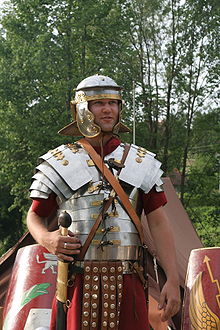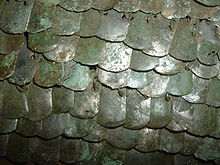Having played around with homemade armor as a kid something like the Roman lorica segmentatac comes to mind -
These are made of horizontal strips that overlap and connect together in the front.
Pretty good stuff, that.
Or the Lorica squamata -
![Image]()
The individual scales (squamae) were either iron or bronze, or even alternating metals on the same shirt. They could be tinned as well, one surviving fragment showing bronze scales that were alternately tinned and plain. The metal was generally not very thick, 0.5 mm to 0.8 mm (0.02 to 0.032 in) perhaps being a common range. Since the scales overlapped in every direction, however, the multiple layers gave good protection. The size ranged from as small as 6 mm (0.25 in) wide by 1.2 cm tall up to about 5 cm (2 in) wide by 8 cm (3 in) tall, with the most common sizes being roughly 1.25 by 2.5 cm (1.5 to 1 in). Many have rounded bottoms, while others are pointed or have flat bottoms with the corners clipped off at an angle. The scales could be flat, or slightly domed, or have a raised midrib or edge. All the scales in a shirt would generally be of the same size; however, scales from different shirts may vary significantly.
The scales were wired together in horizontal rows that were then laced or sewn to the backing. Therefore, each scale had from four to 12 holes: two or more at each side for wiring to the next in the row, one or two at the top for fastening to the backing, and sometimes one or two at the bottom to secure the scales to the backing or to each other.
It is possible that the shirt could be opened either at the back or down one side so that it was easier to put on, the opening being closed by ties. Much has been written about scale armour’s supposed vulnerability to an upward thrust, but this is probably greatly exaggerated.
I always wanted to make a pile of aluminum plates and rivet 'em to a leather welding jacket!
In my opinion 4 mm is way to thick!
I've got some 1/8th inch 5052 aluminum in my shop and no way is anyone gonna shove a blade through that! This is about 3 mm thick.
I'd go down to at least 2 mm aluminum for a scale jacket!
Note that the originals used iron or bronze less than 1 mm thick!
Of course, all bets are off if you are thinking of jousting in this stuff!
For that you need well tempered steel, not aluminum.
I still have my chain mail I made back in 1983 ( it still fits! ) It's constructed of 16 awg steel wire, weights 15 pounds and although the rings are just butted it seems a pretty solid garment.
I reckon my chain mail is proof against any slash or hack with sword or machete. An axe will rip and tear the mail but the blow might be deflected.
Heh, at a renaissance fair in 1983 I got into an argument with a blacksmith about how strong my mail was. I lost the argument, the smith easily cut right through it with a small tomahawk looking axe. It was an easy one hand blow....
Well, he did have arms thicker than my legs, and my mail shirt was put on a log for the test. If I had been wearing the armor I would have been knocked back by the blow and the mail would have rent, but I doubt I'd have been cut. Bruised yes...
Ah, but butted mail is easy to thrust a stout blade through, so I'd be dog meat if someone had a bow!
The very best chain mail with small welded rings will resist stabs and even arrows some. I've met some makers back in the day who told me their mail will resist .45 ACP but I never did believe them!
Apart from the very real concern about arrows another trouble with chain mail is it doesn't do much to distribute the force of the blow and prevent broken bones. Breast plates and to some extent scale armor can because it distributes the blow better, and they are much better against arrows.
The plates restrict movement to much ( IMO ) so I did always want to try scale.
Let us know what you come up with!
Of course, don't forget the Road Warrior tire armor! That stuff is probably pretty stout stuff!









